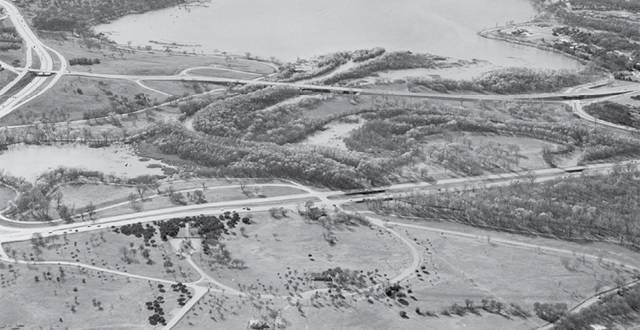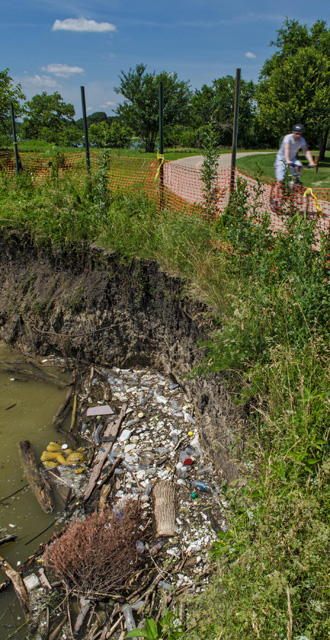
White Rock Lake in 1967 before the dredging in 1974 that formed the peninsula near Mockingbird: Dallas Municipal Archives
The shoreline is wearing away at an alarming pace, and neighbors want to stop it before it’s too late
It’s hard to imagine that a lake can get too much rainfall, but that’s exactly what has happened at White Rock Lake. Lots of rain means softened soil, and in this case softened soil means erosion.
“We had all this nice rain that softened the soil, and then, with all the wave action, that’s the perfect combination for erosion,” says Lis Akin, executive director of For the Love of the Lake.
For the Love of the Lake identified a section of shoreline on the peninsula south of the White Rock Dog Park that has lost 14 feet since 2009.
Walkers, runners and cyclists who use the trail that edges the shoreline of the peninsula between East and West Lawther come within several feet of the erosion, which is rapidly inching its way toward the trail. The precarious drop-off, marked with orange fencing, lost more than three feet from June to August, and it’s only going to get worse, says Akin.
“We’re trying to move forward as quickly as possible,” she says. “I’m alarmed by it myself. Nobody knew that it was going to lose three feet over the summer — that’s really fast.”
The problem is the peninsula is man-made, says Richard Akin, a member of For the Love of the Lake and the senior engineer for McCommas Bluff Landfill. “So, it’s not the most stable material, and the lake’s reclaiming it,” he says.
The entire peninsula along Mockingbird was created as a result of the 1974 dredging, says Sally Rodriguez with the Dallas Park and Recreation Department. The lake has to be periodically “dredged,” Rodriguez explains.
“In very layman’s terms, as the creek flows into the lake, it brings silt and dirt and everything else with it. The lake gets shallower and shallower, and so periodically [the city] has to go in and dredge it all up.”
That means the silt is pulled out of the lake and dumped where the peninsula is now. Following the 1974 dredging, it was several years before the ground was solid enough to walk on, and it probably was never meant for recreational purposes, Rodriguez points out.
All of this contributes to the erosion happening today.
“Walk along the shoreline, and you can actually see where the damage is,” Richard Akin says. “You can also see the danger where the orange fencing is. If a cyclist doesn’t take that turn properly — or I’m thinking more of children — I don’t want to see anybody go off the edge because, for one, some of that debris is exposed there, and it’s not going to be a pleasant landing.”
The city has to decide how to fix the problem. First, the city plans to temporarily re-route the trail so it doesn’t veer so close to the ever-encroaching drop-off.
“That buys them time,” Richard Akin says, “but it’s not going to be the end-all solution, because it’ll keep moving in.”
Because the entire peninsula is man-made, he explains, all of it is at risk of eventually eroding away, especially if no effort is made to control it.
In the end, the city will have to determine how to protect the shoreline.
Chris Maman with EBG Engineering has surveyed the eroding sites, and Tim Abrams with Terracon performed a “geo-technical” soil analysis in September. Another engineer, Chris Robertson with Hayward Baker, will take the results from both entities and work with the city to determine the best solution.
They have several options for how to armor the shoreline: “One of the ways they can do that is concrete walls, which is very expensive, or riprap walls, which are hydrostatically more appealing,” Richard Akin says.
Baker will brainstorm some designs, and then the park department will give them the green or red light.
Armoring the eroding areas of the lake likely will cost about $200,000, Lis Akin says. So fundraising — and lots of it — is in order.
Leong Lim, program manager with engineering and site development in the park department, says the city tried to obtain funding for erosion control in the 2012 bond package, but it didn’t get the go-ahead.
Then the shoreline fell three more feet over the summer.
“We were kind of torn because there’s no funding for this,” Lim explains.
Lucky for the city, For the Love of the Lake is already on it, searching for both funding and volunteer services from community members who are willing to pitch in and help stave off erosion — for a while, at least.
“You’re not going to stop it; it’s going to happen,” Richard Akin says. “It’s erosion control, not prevention. But with maintenance, as long as it’s cared for, it could last indefinitely.”
For the Love of the Lake wants construction to start around the beginning of the year, but as with anything involving politics, there’s a process by which the organization has to abide. Members will have to present all the gathered information to the White Rock Lake task force and the park board, and because it’s a public park, they’ll also have to obtain a permit for the work. Once construction begins, sections will have to be closed to the public.
For those interested in donating to the erosion project
visit whiterocklake.org. Or the mailing address is 381 Casa Linda Plaza, PMB 281, Dallas, TX 75218.







